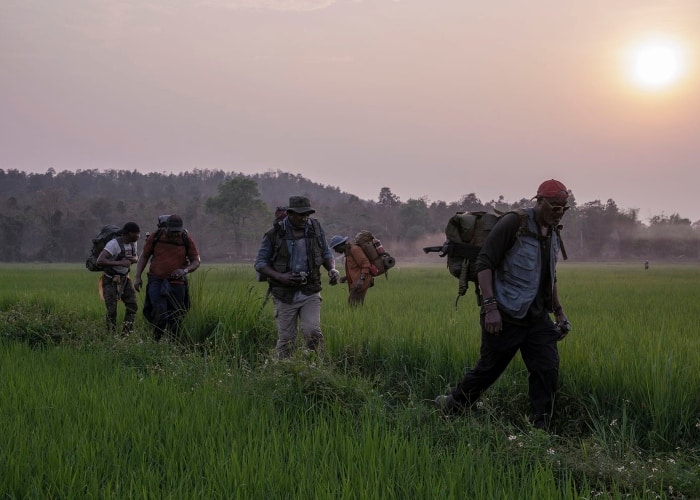
No movie is a single thing as various elements go into every frame, but sometimes generalizations are still accurate. Mention 80s action movies and most people will probably picture the same kinds of explosive visuals, generic beats, and inappropriate character behaviors. Mention Spike Lee‘s filmography and audiences think smart, aggressive, socially conscious film-making intent on exploring race in America even when you think it isn’t. Da 5 Bloods is a Spike Lee joint in the framework of an 80s action movie, and while the former is far more successful than the latter, both halves merge to create something flawed but highly memorable.
The story offers up a perfectly basic narrative most likely credited to screenwriters Danny Bilson and Paul De Meo — four Vietnam vets return nearly fifty years later in search of lost gold and the remains of their fallen friend — that’s then given new purpose through rewrites by Lee and Kevin Willmott. The setup remains, but the story’s focus on treasure hunt and modern-day action now takes a back seat to observations and conversations about Black Americans fighting for a nation that continually fights back against the idea that Black lives are every bit as deserving of American love, respect, and protection.
An opening montage of archival footage from the 60s featuring Muhammad Ali, Malcolm X, Bobby Seale, and others talking about the United States sending Black bodies into immoral wars without reason or recompense is inter-cut with news footage from Vietnam showing the machinery of war, human collateral damage, and Black soldiers. Real-world people and events appear on the screen throughout including drawings or photos of Crispus Attucks and Milton L. Olive III — both Black men who sacrificed their lives defending the U.S. against its outward enemies — and another montage at the end gives voice to Martin Luther King Jr. and the Black Lives Matter movement.
The story proper opens in modern day Ho Chi Minh City, formerly Saigon, as four old friends reunite with purpose. Otis (Clarke Peters), Eddie (Norm Lewis), Melvin (Isiah Whitlock Jr.), and Paul (Delroy Lindo) have each faced the traumas of war and the different, but often related, traumas of post-war life. One is broke, another is lost in life, a third is discovering that he left a child behind when he left Vietnam, and then there’s Paul. His MAGA hat already shows him to be troubled, but conversations and escalating engagements with the Vietnamese locals reveals a man who’s as against non-Americans as he is for “President Bone Spurs.” (The name Trump is never mentioned.) There’s a warmth to their reunion, but small frictions are evident and are only magnified with the surprise arrival of Paul’s estranged son, David (Jonathan Majors).
The rest of the film’s “plot” elements, from the smarmy Frenchman (Jean Reno) you know is going to be trouble to a trio of activists (including Mélanie Thierry and Paul Walter Hauser) who seemingly exist solely as convenient foreshadowing, move exactly where you suspect. They all do good work, but they don’t exactly feel at home in this story. Johnny Trí Nguyen and Van Veronica Ngo, as a modern-day tour guide and Hanoi Hannah, respectively, fair far better as Lee’s film finds a kinship between Black Americans and the Vietnamese people caught up in a war between superpowers. Action beats in the present are wholly competent, if unsurprising in their outcomes, while flashbacks to half a century prior suffer some as the four leads play themselves fifty years younger. Blame Martin Scorsese and The Irishman (2019), but Lee avoids CG aids and instead simply lets the old, gray-haired actors run around the jungle with the notably younger Chadwick Boseman (as the friend whose remains they’ve come to collect). Your mileage may vary as far as it being a distraction, but it’s hard not to respect Lee’s lack of concern on the matter, especially as a posed photo of the characters during the war appears to show them looking noticeably younger via makeup/effects.
Marvin Gaye’s songs and Terence Blanchard‘s punctuating score work with Newton Thomas Sigel‘s cinematography to capture the times, places, and people beautifully, but more than that they complement Lee’s themes of recognition, recovery, and refusal to back down. “Let nobody use our rage against us” is more than mere wishful thinking, and as Lindo’s Paul marches alone through a stifling jungle and speaks directly to the camera — to us — he cements himself not just as the film’s most dynamic character but also as one of the most memorable and haunting in Lee’s filmography.
Da 5 Bloods is a political statement in the guise of an action movie, and as it tear into films like Rambo: First Blood Part II (1985) and Missing in Action (1984), offers knowing nods towards the likes of Apocalypse Now (1979) and The Treasure of the Sierra Madre (1948), and shifts aspect ratios with controlled abandon, it’s clear that Lee has no interest in even making a conventional action movie. Like his own BlackKklansman (2018) before it, this is popular entertainment as protest, and while he doesn’t balance the two nearly as well here, the end result is still a must-see film that could only have come from his distinctly creative and furious vision.
Related Topics: Da 5 Bloods, Netflix, Spike Lee
